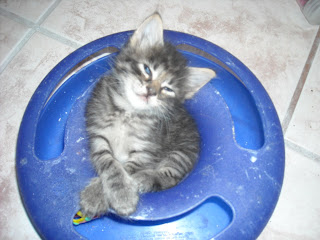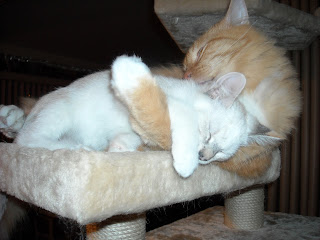Sunday, December 9, 2012
The best way to keep a cat from scratching and biting
When a cat gets too aggressive, I have found if you hold the cat down by scruffing and holding the cat down until she calms down. I have observed mother cats doing that to kittens. I have a high strung female who gets mean and harrases her two brothers and I.
I found that this works. I learned this from observing the mothers and kittens I have fostered.
http://cats.about.com/od/behaviortraining/ht/ScruffingCat.htm
I found that this works. I learned this from observing the mothers and kittens I have fostered.
http://cats.about.com/od/behaviortraining/ht/ScruffingCat.htm
Monday, November 19, 2012
My 6 legged cat
Friday, November 16, 2012
10 things to know about fostering kittens
Fostering kittens is one of the easiest things you can do to save little lives in an era of cat overpopulation. Every year, thousands of cats and kittens are killed simply because there isn't room for them at the rescue shelters. Just by letting a foster kitten stay in your home until space at the shelter opens up, you can give a kitten a chance at a healthy and happy life.
Cats are fairly self-sufficient animals, and depending on the age of the kittens you're fostering, they won't be much more trouble. But you may still need a few supplies:
1. A Little Spare Room. Until they're old enough to be tested for feline illnesses, you'll want to keep foster kittens separated from your resident pets and out from underfoot. If you have a spare room that you can dedicate to foster kittens, so much the better, but if not, a bathroom or even a closet will work. For the safety of the foster kittens and for your peace of mind, you may want to invest in a cat playpen. These wire cat cages can be had for less than $100. Cat playpens provide generous shelter for your foster kittens and fold down to about six inches so that they can be stored under the bed when you're not fostering. The benefits of such a cage are numerous, including the ability to keep your foster kittens from getting hurt when you can't be there to supervise them as well as keeping them separated from your resident pets. Such playpens have ample room for a cat bed, food, and a litter box--everything your foster kittens need when you're not playing with them.
2. Food. If your foster kittens are still nursing, you'll need a special formula to feed them in their bottles. Cow's milk won't work and can make your foster kittens sick. Luckily, KMR Milk Replacer for Kittens is sold in any pet store and can even be purchased through Amazon.com if need be. It comes in liquid and powder form. If your foster kittens are older and eating solid food, you'll want to pick up some high protein kitten food for them.
3. Dishes. You can buy a small kitten dish that has a divided cup for food and water. These are nice because they're hard for the foster kittens to tip over. However, most kittens will accidentally drop their food into their water, so you may be better off buying two of these and placing them slightly apart.
4. Litter Pan. Kittens will use the litter box on their own, starting as early as three weeks. Unfortunately, they may be too little to climb into a full-sized litter pan. For this reason, you'll want to use a disposable foil cake or pie pan until they're big enough to climb into a larger box.
5. Litter. Foster kittens sometimes accidentally eat little pieces of litter. (They are still learning what food is.) For this reason, avoid clumping litter because it can harm them if ingested.
6. Wetnaps. Foster kittens can be like toddlers on occasion. They want to get into everything and they sometimes they spill things on themselves. This phase passes very quickly for a kitten, but you'll want to keep some pet-friendly wet naps nearby to wipe messy little kitten faces or paws.
7. Toys. You may be tempted to buy a lot of expensive cat toys for your foster kittens. Save the money for the KMR. What kittens love to play with most are things that can be found in your kitchen already. Paper bags are a big favorite. Twist-ties and paper balls are also popular.
8. Cat Brush. If you're fostering long-haired kittens, you'll want to get them used to being brushed every day. (If your foster kittens are short-hairs, just make sure to engage in a vigorous petting session every day and there shouldn't be any need to brush them.)
9. Claw Clippers. One of the best things you can do for your foster kittens is to get them used to having their claws trimmed. Play with their paws every day, and use a pair of claw clippers to snip the ends according to the directions. Your foster kittens will be less likely to scratch and ruin furniture if you do this, and they will also be more fun to play with when their claws aren't so sharp.
10. Scratching Post. Teach your foster kittens to use a scratching post and they'll be more likely to find a home. Well-behaved kittens grow up to be well-behaved cats, and as a feline foster parent, it's your job to raise them right.
Labels:
10 things,
feline illnesses,
fostering kittens
Friday, November 9, 2012
Monday, October 8, 2012
Subscribe to:
Comments (Atom)













